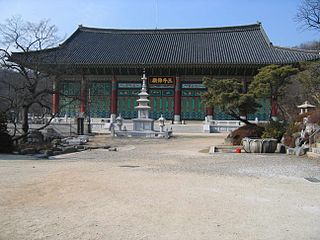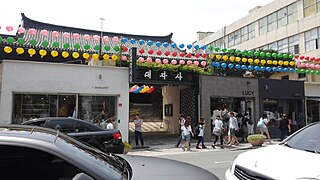Buddhist temples are an important part of the Korean landscape. Most Korean temples have names ending in -sa, which means "monastery" in Sino-Korean. Many temples participate in the Templestay program, where visitors can experience Buddhist culture and even stay at the temple overnight.

Bongwonsa is a South Korean Buddhist temple in Bongwon-dong, Seodaemun District, Seoul, South Korea.

The Jogye Order, officially the Jogye Order of Korean Buddhism, is the representative order of traditional Korean Buddhism with roots that date back 1200 years to the Later Silla National Master Doui, who brought Seon and the practice taught by the Sixth Patriarch, Huineng, from China around 820 CE. The name of the Order, Jogye, was adopted from the name of the village where Patriarch Huineng's home temple, Nanhua Temple, is located,.

Jogyesa is the chief temple of the Jogye Order of Korean Buddhism. The building dates back to the late 14th century and became the order's chief temple in 1936. It thus plays a leading role in the current state of Seon Buddhism in South Korea. The temple was first established in 1395, at the dawn of the Joseon Dynasty; the modern temple was founded in 1910 and initially called "Gakhwangsa". The name was changed to "Taegosa" during the period of Japanese rule, and then to the present name in 1954.

Shilleuksa is a Korean Buddhist temple situated against a low hill on the north side of the river Namhan, three kilometers east of Yeoju in Gyeonggi Province, approximately one-hour southeast of Seoul. The only riverside temple in South Korea, Shilleuksa is a sacred pilgrimage site and a repository of seven Treasures. A 500-year-old aromatic juniper tree and a 600-year-old ginkgo tree stand on the temple grounds.

Bongeunsa is a Korean Buddhist temple located in Samseong-dong, Gangnam-gu in Seoul, South Korea. It was founded in 794 during the reign of King Wonseong by State Preceptor Yeonhoe, then the highest ranking monk of Silla. The temple was originally named Gyeonseongsa. It is located on the slope of Sudo Mountain, across the street from the COEX Mall.

Mangwolsa Station is a metro station on Seoul Subway Line 1. Named after a Silla-era Buddhist temple in the mountains to the west, it is the first station for services leaving Seoul heading north, and lies in the city of Uijeongbu.
Gamnoam is a Buddhist temple of the Jogye Order in Seoul, South Korea. Founded in 1912 it is located at 15 Chungsin-dong in the Jongno-gu area of the city.

Gaeunsa is a Buddhist temple of the Jogye Order in Seoul, South Korea. Founded in 1396 by the Buddhist monk Muhak, it is located at 15 Anam 5-dong in the Seongbuk-gu area of the city.
Gyeongguksa is a Buddhist temple of the Jogye Order in Seoul, South Korea. Founded in 1325 it is located in 753 Jeongneung-dong, in the Seongbuk-gu area of the city.

Gwaneumsa is a Buddhist temple of the Jogye Order in Seoul, South Korea. Believed to have been established in 895, it is located in 519-3 Namhyeon-dong in the Gwanak District of the city.
Naewonsa is a Buddhist temple of the Jogye Order in Seoul, South Korea. It is located in San 1 Jeongneung-dong in the Seongbuk-gu area of the city.
Dalmasa is a Buddhist temple of the Jogye Order in Seoul, South Korea. It is located in 61-34 Heukseok 1-dong in the Dongjak-gu area of the city.

Daegaksa (Korean: 대각사) is a Buddhist temple of the Jogye Order in Seoul, South Korea. It is located in Bongik 2-dong in the Jongno-gu area of the city.
Daeseongsa is a Buddhist temple of the Jogye Order in Seoul, South Korea. It is located at San 140-2 Seocho-dong, in the Seocho-gu area of the city.

Doseonsa (Korean: 도선사) is a Buddhist temple of the Jogye Order in Seoul, South Korea. It is located at 264 Ui-dong, in the Gangbuk-gu area of the city and is the largest temple complex on Bukhansan, the most prominent mountain north of Seoul. The temple was dedicated in 862, though none of its original structures survive.
Manworam (Korean: 만월암) is a Buddhist temple of the Jogye Order in Seoul, South Korea. It is located at San 29-1 Dobong 1-dong, in the Dobong-gu area of the city.

Inwangsa is a Buddhist temple of the Bonwon Order in Mt. Inwangsan, Seoul, South Korea. It is located at San 2 Muak-dong, in the Jongno-gu area of the city. When King Taejo of Joseon Dynasty established the capital city in Seoul, he assigned Josaeng, a monk from a Buddhist temple affiliated to the royal court as the head monk of the new temple to establish it at the site.

Yongmun Station is a station on the Gyeongui–Jungang Line in Gyeonggi-do, South Korea. It was the eastern terminus of the commuter railway, running from Seoul to Yangpyeong County until 2017. Mugunghwa trains also stop at this station.

Iljumun is the first gate at the entrance to many Korean Buddhist temples. Called the "One-Pillar Gate", because when viewed from the side the gate appears to be supported by a single pillar.














